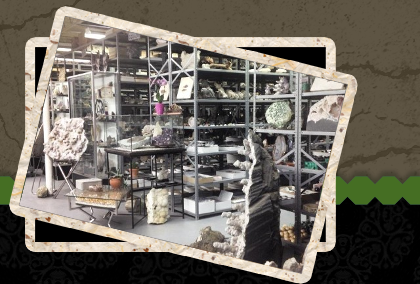| |
A mineral is a naturally occurring substance that is solid and stable at room temperature, representable by a chemical formula, usually abiogenic, and has an ordered atomic structure. It is different from a rock, which can be an aggregate of minerals or non-minerals and does not have a specific chemical composition. The exact definition of a mineral is under debate, especially with respect to the requirement a valid species be abiogenic, and to a lesser extent with regards to it having an ordered atomic structure. The study of minerals is called mineralogy.
There are over 4,900 known mineral species; over 4,660 of these have been approved by the International Mineralogical Association (IMA). The silicate minerals compose over 90% of the Earth's crust. The diversity and abundance of mineral species is controlled by the Earth's chemistry. Silicon and oxygen constitute approximately 75% of the Earth's crust, which translates directly into the predominance of silicate minerals. Minerals are distinguished by, various, chemical, and physical properties. Differences in chemical composition and crystal structure distinguish various species, and these properties in turn are influenced by the mineral's geological environment of formation. Changes in the temperature, pressure, and bulk composition of a rock mass cause changes in its mineralogy; however, a rock can maintain its bulk composition, but as long as temperature and pressure change, its mineralogy can change as well. |
Agate
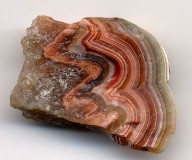
Agate is a microcrystalline variety of silica, chiefly chalcedony, characterized by its fineness of grain and brightness of color. Although agates may be found in various kinds of rock, they are classically associated with volcanic rocks and can be common in certain metamorphic rocks. |
Amethyst
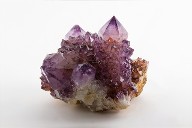 |
Amethyst is a violet variety of quartz often used in jewelry. The name comes from the Ancient Greek ? a- ("not") and μ?θυστος methustos("intoxicated"), a reference to the belief that the stone protected its owner from drunkenness. The ancient Greeks and Romans wore amethyst and made drinking vessels of it in the belief that it would prevent intoxication. It is one of several forms of quartz. Amethyst is a semiprecious stone and is the traditional birthstone for February.
|
Atacamite
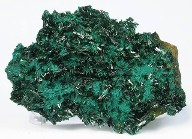
Atacamite is a copper halite mineral: a copper(II) chloride hydroxide with formula Cu2Cl(OH)3.
It was first described for deposits in the Atacama Desert of Chile in 1801.
Atacamite is polymorphous with botallackite, clinoatacamite, and paratacamite. Atacamite is a comparatively rare mineral, formed from primary copper minerals in the oxidation or weathering zone of arid climates. It has also been reported from fumarole deposits, as sulfide alteration products in black smokers and as alteration of ancient bronze and copper artefacts. It occurs in association with cuprite, brochantite, linarite, caledonite,malachite, chrysocolla and its polymorphs. |
Celestite

Celestine or celestite (SrSO4) is a mineral consisting of strontium sulfate. The mineral is named for its occasional delicate blue color. Celestine is the principal source of the element strontium, commonly used in fireworks and in various metal alloys. |
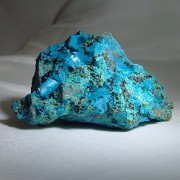
Chrysocolla is a hydrated copper phyllosilicate mineral with formula: Cu2-xAlx(H2-xSi2O5)(OH)4·nH2O (x<1)[1] or (Cu,Al)2H2Si2O5(OH)4·nH2O.[2] The structure of the mineral has been questioned as spectrographic studies suggest material identified as chrysocolla may be a mixture of the copper hydroxide spertiniite and chalcedony. |
Citrine
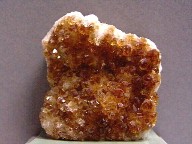
Citrine is a variety of quartz whose color ranges from a pale yellow to brown. Natural citrines are rare; most commercial citrines are heat-treated amethysts or smoky quartzes. It is nearly impossible to tell cut citrine from yellow topaz visually, but they differ in hardness. Citrine has ferric impurities, and is rarely found naturally. Brazil is the leading producer of citrine, with much of its production coming from the state of Rio Grande do Sul. The name is derived from Latin citrina which means "yellow" and is also the origin of the word "citron." Sometimes citrine and amethyst can be found together in the same crystal, which is then referred too as ametrine. |
Copper
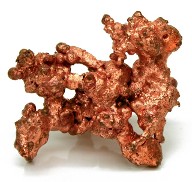
Copper is a chemical element with the symbol Cu (from Latin: cuprum) and atomic number 29. It is a ductile metal with very high thermal andelectrical conductivity. Pure copper is soft and malleable; a freshly exposed surface has a reddish-orange color. It is used as a conductor of heat and electricity, a building, material, and a constituent of various metal alloys.
The metal and its alloys have been used for thousands of years. In the Roman era, copper was principally mined on Cyprus, hence the origin of the name of the metal as ?yprium (metal of Cyprus), later shortened too ?uprum. Its compounds are commonly encountered as copper(II) salts, which often impart blue or green colors to minerals such as azurite and turquoise and have been widely used historically as pigments. Architectural structures built with copper corrode to give green verdigris (or patina). Decorative art prominently features copper, both by itself and as part of pigments.
|
Emerald
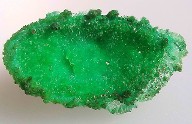
Emerald is a gemstone, and a variety of the mineral beryl (Be3Al2(SiO3)6) colored green by trace amounts of chromium and sometimes vanadium. Beryl has a hardness of 7.5–8 on the 10-point Mohs scale of mineral hardness. Most emeralds are highly included, so their toughness (resistance to breakage) is classified as generally poor. |
Fluorite
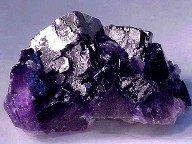
Fluorite (also called fluorspar) is a halide mineral composed of calcium fluoride, CaF2. It is an isometric mineral with a cubic habit, though octahedral and more complex isometric forms are not uncommon.
Fluorite is a colorful mineral, both in visible and ultraviolet, light, and the stone has ornamental and lapidary uses. Industrially, fluorite is used as a flux for smelting, and in the production of certain glasses and enamels. The purest grades of fluorites are a source of fluoride for hydrofluoric acid manufacture, which is the intermediate source of most fluorine-containing fine chemicals. Optically clear transparent fluorite lenses have low dispersion, so lenses made from it exhibit less chromatic aberration, making them valuable in microscopes and telescopes. Fluorite optics are also usable in the far-ultraviolet range where conventional glasses are to absorbent for use. |
Kyanite
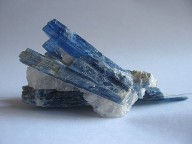
Kyanite, whose name derives from the Greek word kuanos sometimes referred too as "kyanos", meaning deep blue, is a typically blue silicate mineral, commonly found in aluminium-rich metamorphic pegmatites and/or sedimentary rock. Kyanite in metamorphic rocks generally indicates pressures higher than four kilo bars. Although potentially stable at lower pressure and low temperature, the activity of water is usually high enough under such conditions that it is replaced by hydrous aluminosilicates such as Muscovite, pyrophyllite, or kaolinite. Kyanite is also known as disthene, rhaeticite and cyanide.
Kyanite is a member of the aluminosilicate series, which also includes the polymorph andalusite and the polymorph sillimanite. Kyanite is stronglyanisotropic, in that its hardness varies depending on its crystallographic direction. In kyanite, this anisotropism can be considered an identifying characteristic.
At temperatures above 1100 °C kyanite decomposes into mullite and vitreous silica via the following reaction: 3(Al2O3·SiO2) → 3Al2O3·2SiO2 + SiO2. This transformation results in an expansion. |
Lapps Lazuli
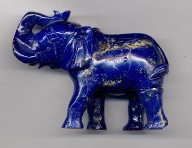
Lapis lazuli (sometimes abbreviated to lapis) is a deep blue semi-precious stone that has been prized since antiquity for its intense color.
Lapis lazuli was being mined in the Sari Sang mines and in other mines in the Badakhshan province in northeast Afghanistan as early as the 7th millennium BC,Lapis beads have been found at neolithic burials in Mehrgarh, the Caucasus, and even as far from Afghanistan as Mauritania. It was used for the eyebrows on the funeral mask of King Tutankhamen (1341–1323 BC).
At the end of the Middle Ages, lapis lazuli began to be exported to Europe, where it was ground into powder and made into ultramarine, the finest and most expensive of all blue pigments. It was used by the most important artists of the Renaissance and Baroque, including Massaccio, Perugino,Titian and Vermeer, and was often reserved for the clothing of the central figure of the painting, especially the Virgin Mary.
Today mines in northeast Afghanistan are still the major source of lapis lazuli. Important amounts are also produced from mines west of Lake Baikalin Russia, and in the Andes mountains in Chile. Smaller quantities are mined in Italy, Mongolia, the United States and Canada. |
Malachite
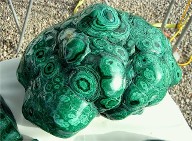
Malachite is a copper carbonate hydroxide mineral, with the formula Cu2CO3(OH)2. This opaque, green banded mineral crystallizes in themonoclinic crystal system, and most often forms botryoidal, fibrous, or stalagmitic masses, in fractures and spaces, deep underground, where the water table and hydrothermal fluids provide the means for chemical precipitation. Individual crystals are rare but do occur as slender to acicularprisms. Pseudomorphs after more tabular or blocky azurite crystals also occur. Typical malachite is laminated and whether or not microbes intervene in its formation is unknown. |
Petrified Wood
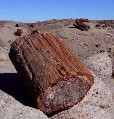
Petrified wood (from the Greek root petro meaning "rock" or "stone"; literally "wood turned into stone") is the name given to a special type of fossilized remains of terrestrial vegetation. It is the result of a tree or tree-like plants having completely transitioned to stone by the process of permineralization. All the organic materials have been replaced with minerals (mostly a silicate, such as quartz), while retaining the original structure of the stem tissue. Unlike other types of fossils which are typically impressions or compressions, petrified wood is a three-dimensional representation of the original organic material. The petrifaction process occurs underground, when wood becomes buried under sediment and is initially preserved due to a lack of oxygen which inhibits aerobic decomposition. Mineral-laden water flowing through the sediment deposits minerals in the plant's cells; as the plant's lignin and cellulose decay, astone mould forms in its place. The organic matter needs to become petrified before it decomposes completely. A forest where such material has petrified becomes known as a petrified forest. |
Pyrite
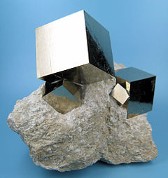
The mineral pyrite, or iron pyrite, also known as fool's gold, is an iron sulfide with the formula FeS2. This mineral's metallic luster and pale brass-yellow hue give it a superficial resemblance to gold, hence the well-known nickname of fool's gold. The color has also led to the nicknames brass,brazzle, and Brazil, primarily used to refer to pyrite found in coal.
|
Ruby
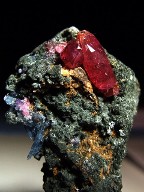
A ruby is a pink to blood-red colored gemstone, a variety of the mineral corundum (aluminium oxide). The red color is caused mainly by the presence of the element chromium. Its name comes from ruber, Latin for red. Other varieties of gem-quality corundum are called sapphires. The ruby is considered one of the four precious stones, together with the sapphire, the emerald and the diamond.
Prices of rubies are primarily determined by color. The brightest and most valuable "red" called blood-red, commands a large premium over other rubies of similar quality. After color follows clarity: similar to diamonds, a clear stone will command a premium, but a ruby without any needle-like rutile inclusions may indicate that the stone has been treated. Cut and carat (weight) are also an important factor in determining the price. |
Sapphire
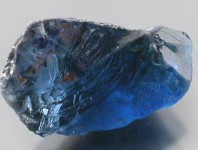
Sapphire is a gemstone variety of the mineral corundum, an aluminium oxide (α-Al2O3). Trace amounts of other elements such as iron, titanium, chromium, copper, or magnesium can give corundum blue, yellow, purple, orange, or a greenish color. Chromium impurities in corundum yield a pink or red tint, the latter being called aruby.
Commonly, sapphires are worn in jewelry. Sapphires may be found naturally, by searching through certain sediments (due to their resistance to being eroded compared to softer stones) or rock formations. They also may be manufactured for industrial or decorative purposes in large crystalboules. Because of the remarkable hardness of sapphires—nine on the Mohs scale—and of aluminium oxide in general, sapphires are used in some non-ornamental applications, including infrared optical components, such as in scientific instruments; high-durability windows; wristwatch crystals and movement bearings; and very thin electronic wafers, which are used as the insulating substrates of very special-purpose solid-state electronics(most of which are integrated circuits). |
Smoky Quartz
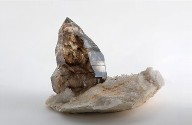
Smoky quartz is a brown to black variety of quartz. Like other quartz gems, it is a silicon dioxide crystal. The smoky colour results from free silicon, formed from the silicon dioxide by natural irradiation. |
Tourmaline
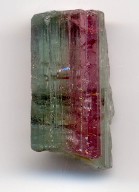
Tourmaline is a crystal boron silicate mineral compounded with elements such as aluminium, iron, magnesium, sodium, lithium, orpotassium. Tourmaline is classified as a semi-precious stone and the gemstone comes in a wide variety of colors. The name comes from theSinhalese word "Thuramali" or "Thoramalli", which applied to different gemstones found in Sri Lanka. |
|
|
|
|
| |
E-mail:
auroramineral@optim-um.net
Number:
1-516-623-3800
Fax:
516-623-0197
Hours:
Mon-Fri
9am-5pm EST (Please call in advance) |
| |
|
